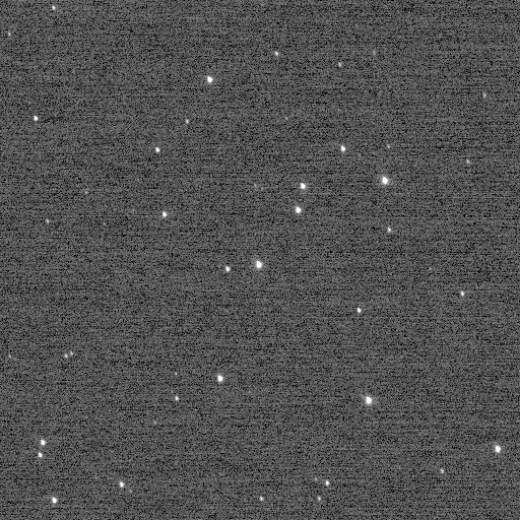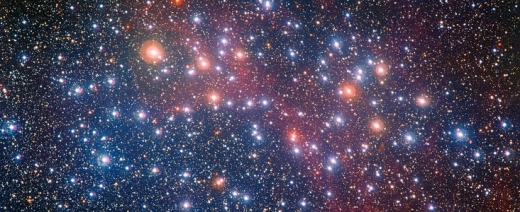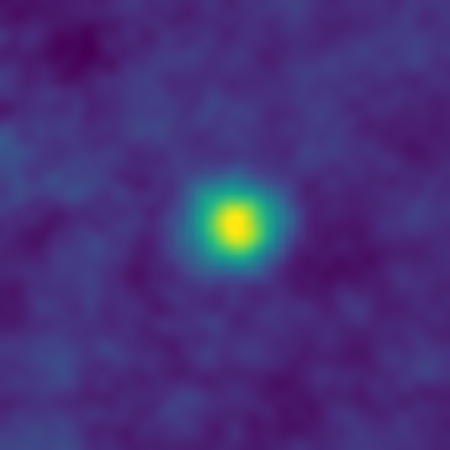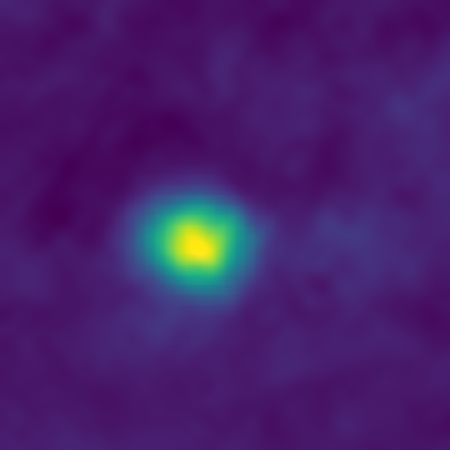New Horizons continues to push our limits, revealing new sights as it makes its way through the Kuiper Belt enroute to a January 1, 2019 encounter with the KBO 2014 MU69. No object this far from the Sun has ever been visited by a spacecraft. Adding further interest is the unusual nature of the target, for MU69 is thought to be a contact binary, two independent bodies that have touched (comet Churyumov-Gerasimenko is likely a contact binary as well). The beauty of this kind of exploration, of course, is that we so often get surprised when we reach our destination.
Below is an image of NGC 3532, also known as the Wishing Well Cluster, an open cluster in the constellation Carina that has its own place in our observational history, becoming the first target ever observed by the Hubble Space Telescope. That was in May of 1990; this is New Horizons’ view in December.
The Wishing Well Cluster is a naked eye object for southern hemisphere observers, one of the most spectacular clusters of its type. It’s worth noting that astronomer John Herschel (1792-1871) considered NGC 3532 one of the most beautiful clusters in the sky, describing “several elegant double stars” during a residence in southern Africa in the 1830s. The New Horizons image below doesn’t bring out its aesthetic appeal (see the following image for that), but it’s stirring nonetheless when we consider how far from home the image was made.

Image: For a short time, this New Horizons Long Range Reconnaissance Imager (LORRI) frame of the “Wishing Well” star cluster, taken Dec. 5, 2017, was the farthest image ever made by a spacecraft, breaking a 27-year record set by Voyager 1. About two hours later, New Horizons later broke the record again. Credit: NASA/Johns Hopkins University Applied Physics Laboratory/Southwest Research Institute.
Here we’re seeing the work of New Horizons’ Long Range Reconnaissance Imager (LORRI), taken when the spacecraft was 6.12 billion kilometers (40.9 AU) from Earth. And yes, that puts it further away than Voyager 1 was when it took the ‘Pale Blue Dot’ photo back in 1990 — Voyager at that time was 6.06 billion kilometers away. Because the Voyager cameras were turned off not long after that image was made, its distance record for images has stood until now.
By way of comparison, and in the spirit of the great John Herschel, here’s the Wishing Well Cluster in all its glory in an image from the European Southern Observatory’s La Silla site, using the Wide Field Imager instrument.

Image: The MPG/ESO 2.2-metre telescope at ESO’s La Silla Observatory in Chile captured this richly colourful view of the bright star cluster NGC 3532. Some of the stars still shine with a hot bluish colour, but many of the more massive ones have become red giants and glow with a rich orange hue. Credit: ESO/G. Beccari.
Two hours after the Wishing Well image from New Horizons, LORRI set still another distance record, imaging Kuiper Belt objects 2012 HZ84 and 2012 HE85. The spacecraft’s travels in the Kuiper Belt will be replete with observations of KBOs other than MU69, although none will be approached nearly as closely as the latter. This update from JHU/APL tells us that the plan is to observe at least two dozen KBOs, dwarf planets and Centaurs, hoping to determine their shapes and examine their surface properties, while likewise looking for moons and rings. Meanwhile, measurements of plasma, dust and the neutral-gas environment in this region proceed, useful data for future missions to the heliosphere and beyond.

Image: With its Long Range Reconnaissance Imager (LORRI), New Horizons has observed several Kuiper Belt objects (KBOs) and dwarf planets at unique phase angles, as well as Centaurs at extremely high phase angles to search for forward-scattering rings or dust. This December 2017 false-color image of KBO 2012 HZ84 is, for now, one of the farthest from Earth ever captured by a spacecraft. At the time it was among the closest observations yet made of the mysterious, distant objects known as KBOs. Credit: NASA/Johns Hopkins University Applied Physics Laboratory/Southwest Research Institute.

Image: A second KBO image. Here, New Horizons’ range to the KBO 2012 HE85 was only 51 million kilometers, or 0.34 AU – closer than the planet Mars ever comes to Earth. Credit: NASA/Johns Hopkins University Applied Physics Laboratory/Southwest Research Institute.



While not a surprise, it is still interesting to note is that both objects
are elongated.
Any chance New Horizons might try for its own version of Voyager 1’s Pale Blue Dot images? The Voyager probe’s cameras were not really meant to take images of objects so far away, either, so that cannot be the excuse.
When I was young, Pluto was imaged with less resolution than these KBOs. How far we have come. Soon MU69 will become another beautifully imaged body to add to the atlases.
At the range taken, I don’t think either object was resolved by the camera. They’re certainly not more than a few pixels across at the detector.
The elongation in the KBO images is probably due to spacecraft motion during the exposure and optical distortion. The image of the “Wishing Well” star cluster show a similar distortion.
White House announces request to cancel WFIRST.
Off topic.
Still in the conceptual stage WFIRST is today supposed 7-8 years from launch. JWST was also 7-8 years from launch from 1999 until 2012! During this phase it’s (US)budget rose from 1 to 9 billion.
I am aware of the changes and additions made to WFIRST that contributed to a near doubling of its initial price. However this far out from deployment further cost increases seem inevitable.
Is anyone well versed in the cost estimate process for such projects? The cost explosion seen in JWST suggests that these estimates are exercises in the impossible. When many elements of the project haven’t even been fully functionally conceptualized, how is a cost estimate even considered serious?
Some may even quietly speculate on a substratum of hope that one such object may turn out to be an unmanned (unaliened?) sentinel outpost…
I’m not afraid to say so publicly, although I don’t hold my breath that any such distant object is a derelict (or just quiet) alien sentinel probe. But if we *never* look for such things (or even just keep an eye out for them while making other observations), our chances of finding any sentinel probes–if they’re there, and if they can’t or don’t want to make their presence known–will be zero. Also:
If New Horizon’s cameras can look sunward without damaging themselves, another solar system “family portrait,” as ljk suggested, would be worth trying, because Voyager 1’s original one didn’t show all of the planets. Mercury was too close to the Sun to be seen, Mars was also too close to the Sun (along the spacecraft’s line of sight) to be visible, and Pluto was too dim to show up. New Horizons should be able to see a crescent Pluto (and possibly also Charon, and at least some of the smaller moons), and its improved cameras (with solid-state detectors; the Voyagers used vidicon tube TV cameras) might be able to see Mercury if it was at or near its greatest elongation (from the spacecraft cameras’ vantage point–their optical filters might also help to make it stand out from the solar glare), and:
Those who named most of the constellations and star clusters must have been very imaginative, because the Wishing Well Cluster doesn’t look like a well–or like any object at all–to me; it looks as much like a swarm of bees as does the Beehive cluster itself.
Talking of surveying KBOs, is there any serious momentum behind making this proposed fast orbiter mission to Haumea a reality? In my opinion, it is the most interesting of the dwarf planets, it would be fascinating to see it (and its rings and moons) up close.
That’s a most interesting proposal, Andy! If two of the spacecraft were built, which is often done (in other cases, rather close analogs are built for thermal testing, and they can be upgraded to become flight articles–the Mariner 10 mission had this option if the flight vehicle had been lost), the spare could be sent to ‘Oumuamua. If the Falcon Heavy was used as the launch vehicle (with one or more extra STAR solid motor solid kick stages, if necessary), the launch costs for both missions would be affordable.
I wonder if it makes any sense to compare this LORRI image of the Wishing Well cluster with ones taken from Earth. A 40 AU baseline might reveal parallax displacements of some of the stars that would enable distance measurements not otherwise obtainable.
I wondered that too. But it turns out that LORRI’s ability to determine the precise position (or relative position) of a star isn’t good enough to improve on results from the Gaia spacecraft, even with the much larger baseline.
Astronomers Are Already Planning for the Next ‘Pale Blue Dot’
In 2019, the New Horizons spacecraft will attempt to break the record for the farthest image ever taken of Earth.
Marina Koren
February 13, 2018
In 1977, humans launched twin robotic probes into space several weeks apart. The two Voyager spacecraft barreled away from Earth for a tour of our planet’s siblings in the solar system.
At each encounter, the Voyagers set records for the best-looking pictures of these planets humanity had ever taken, far better than anything seen through a telescope. There was Jupiter, furiously churning with gargantuan storms. There was Saturn, encircled by vinyl-like rings. There was Uranus, robin’s-egg blue and featureless. There was Neptune, cloud-speckled and cerulean.
When the planetary safari was over, Voyager 1 turned back toward Earth in 1990 for one last picture before its cameras were shut off. The resulting photograph, the “Pale Blue Dot” image at the top of this story, became the most distant image ever taken of Earth.
Voyager has held onto that record for 28 years. But a year from now, it may get knocked out of first place.
Sometime after January 2019, New Horizons, the spacecraft that brought us photos of the heart-shaped terrain on Pluto, will turn back toward Earth. The probe’s camera, the Long-Range Reconnaissance Imager, or LORRI for short, will start snapping away. Nearly three decades after the original, humanity will get another “Pale Blue Dot.”
Full article here:
https://www.theatlantic.com/science/archive/2018/02/new-horizons-pale-blue-dot-nasa/553160/
To quote:
“We’ve been talking about it for years,” says Andy Cheng of the plan to take another ‘Pale Blue Dot’ image. Cheng is a scientist at Johns Hopkins University’s Applied Physics Laboratory and the principal investigator for LORRI.
It’s a risky move. The attempt requires pointing LORRI close enough to the sun so that objects in the darkness are illuminated, but not so close that sunlight damages or destroys the camera.
“But we’re going to do it anyway, for the same reason as before,” Cheng says. “It’s just such a great thing to try.”
The photo shoot will take considerable coordination. “All activities on the spacecraft need to be choreographed in elaborate detail and then checked and checked again,” Cheng says. “Taking a LORRI image involves more than just LORRI—the spacecraft needs to point the camera in the right direction, LORRI needs to be operated, the image data needs to be put in the right place and then accessed and transmitted to Earth, which requires more maneuvers of the spacecraft, all of which needs to happen on a spacecraft almost 4 billion miles away.”
At that distance, our home in the universe will look tremendously small. “It’ll be very hard to pick out that tiny, bright dot,” he says.
The consequences of a nearby supernova on the early Solar
System.
“If the Sun was born in a relatively compact open cluster (half-mass radius ? 103 stars, it is quite likely that a massive
(>? 10 M) star was nearby when it exploded in a supernova. The repercussions of a supernova can be rather profound, and the
current Solar System may still bear the memory of this traumatic event. The truncation of the Kuiper belt and the tilt of the ecliptic
plane with respect to the Sun’s rotation axis could be such signatures. We simulated the effect of a nearby supernova on the young
Solar System using the Astronomical Multipurpose Software Environment. Our calculations are realized in two subsequent steps in
which we study the effect of the supernova irradiation on the circumstellar disk and the effect of the impact of the nuclear blast-wave
which arrives a few decades later. We find that the blast wave of our adopted supernova exploding at a distance of 0.15–0.40 pc and
at an angle of 35?–65? with respect to the angular-momentum axis of the circumsolar disk would induce a misalignment between the
Sun’s equator and its disk to 5?.6 ± 1?.2, consistent with the current value. The blast of a supernova truncates the disk at a radius
between 42 and 55 au, which is consistent with the current edge of the Kuiper belt. For the most favored parameters, the irradiation by
the supernova as well as the blast wave heat the majority of the disk to >? 1200 K, which is sufficiently hot to melt chondrules in the
circumstellar disk. The majority of planetary system may have been affected by a nearby supernova, some of its repercussions, such
as truncation and tilting of the disk, may still be visible in their current planetary system’s topology. The amount of material from
the supernova blast wave that is accreted by the circumstellar disk is too small by several orders of magnitude to explain the current
abundance of the short live radionuclide 26Al.”
https://arxiv.org/pdf/1802.04360.pdf
Paul, since you use the distance from Earth in your article, not the Sun, there is this small technical issue that, NH is moving towards Earth right now, maybe so for last Dec as well. That means the 2nd photo it took did not break the record again. Just saying. :-)
If the “brane craft” concept works as planed, a 2D ultralight rocket with about 4000 ISP, it could be scaled up to carry larger probes in a sail configuration. And the electrospray ion thrusters can be reconfigured for higher specific impulse, lower thrust, if that would be optimal.
For some missions the need to orient it towards the sun for maximum power could be problematic, but it’s ideal for missions to Kuiper belt objects. The best part is that it’s easily tested in vacuum chambers, and ought to scale well. And in a sail configuration it can be quite a bit simpler than the original free flying sheet concept.
Given that it’s basically integrated circuit technology, implementation should be fairly rapid.
OSIRIS-REx Captures New Earth-Moon Image
http://spaceref.com/moon/osiris-rex-captures-new-earth-moon-image.html
Valentine’s Day also anniversary of Voyager’s famous ‘Pale Blue Dot’ photo
http://triblive.com/usworld/world/13303435-74/story
Quote by Carl Sagan:
“There is perhaps no better demonstration of the folly of human conceits than this distant image of our tiny world,” he wrote. “To me, it underscores our responsibility to deal more kindly with one another, and to preserve and cherish the pale blue dot, the only home we’ve ever known.”